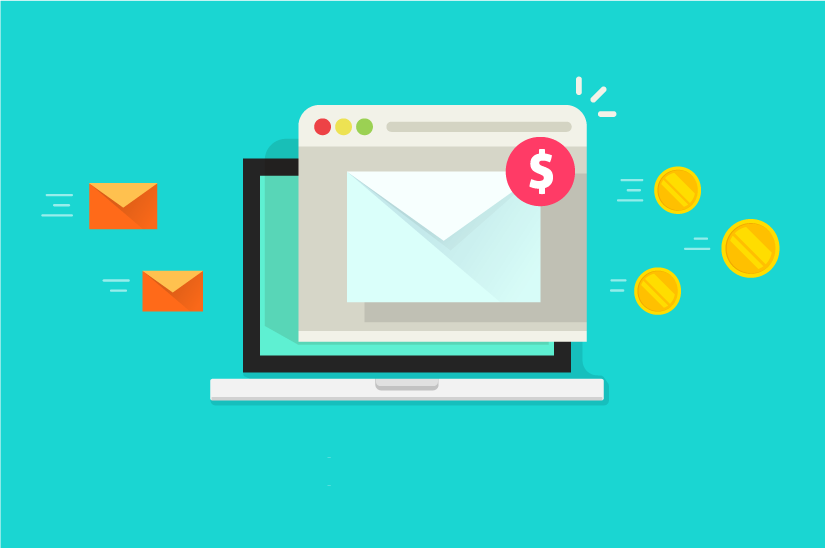
Have you ever seen an email with pop-ups or a big, flashy banner ad at the top and wondered how much that brand paid to have its ad placed there? Today, digital advertisements catalyze positive awareness and drive profits. This is what makes digital marketing efforts more crucial.
As a marketer and advertiser, it is important to understand the impact of your content and campaigns on your target audience. Effective email ad strategies can accomplish good results, but it is also essential to know how much money you should spend to ensure your email campaigns and content are seen by your target audience. This is where it’s helpful to understand the email CPM.
In digital marketing, cost per mile (CPM) is what an advertiser pays for a thousand impressions of an ad. It is a pricing method and an ad metric allowing businesses to analyze the impact and cost-effectiveness of their marketing campaigns.
So, what is email marketing CPM? What should yours be? And how does it affect your business?
What Is CPM in Email Marketing?
In email marketing, CPM or CPT (cost per thousand) refers to the cost of sending a thousand emails. This pricing model is used by email service vendors to cover the cost of bandwidth, mail server, bounce management, and deliverability services.

Image Source: forbes.com
The majority of email service vendors use a tiered pricing structure. As the number of sent emails increases, the email CPM rate usually decreases. The CPM for healthy email advertising is between $15 and $35. But your CPM can reach over $100 in rare cases when your ad has an audience that buys luxury products.
Some email service providers may use different price structures. For instance, the email CPM rate may depend on the total number of contacts in the client’s database. Fixed fees and subscriptions are other common pricing schemes.
The total number of emails sent is calculated over a specific time, month, or year. Companies that send many email campaigns can negotiate a lower CPM cost with their email vendor.
How to Calculate CPM in Email Marketing
To find CPM for email ads, you have to consider the email company, the email list, and targeting preferences. A targeted email list implies higher open and click rates, resulting in higher email CPM rates.
Therefore, email CPM is calculated by dividing the fee charged by the email marketing company by the total number of subscribers and then multiplying the outcome by 1000.
CPM = (Fee charged ÷ Total number of subscribers) X 1000
What Is a Good Email CPM?
A good email CPM depends on various factors that are mostly determined by the budget and goal of the company running the advertisement campaign. An average CPM for ads lies between $3-10, and these rates vary significantly across advertising platforms, industries, target audiences, locations, and more.
Generally, email CPM marketing is more about quality compared to quantity. At times a lower CPM cost may seem perfect, but if the impressions do not turn into conversions, then they are less valuable than the pricier CPM strategies.
A good email CPM will help you meet or exceed your set goals. For instance, if your business pays less but comes out with good results, and another business pays a higher price and achieves its goals, both businesses have found a good email CPM despite the disparity between the amounts they spent.
Therefore, you shouldn’t evaluate CPM by cost alone. Use its results and return on investment if you want to find a good email CPM.
Why should Marketers Use CPM Email Marketing?

CPM email marketing offers many benefits for businesses regardless of their size. An effective email CPM can boost your brand’s reach and recognition, create tailored ads that resonate with your intended audience, or deliver sales conversions. Here are the reasons why email marketers should use CPM.
1. To Test Offers
If you are about to launch a multi-million dollar email marketing campaign, it is sensible to test it first. Internal assessments and focus groups may help, but that’s nothing compared to releasing your ad campaign into the wild to estimate customer response. Sending a million emails will cost a few thousand dollars, but the analytics from this send will help you improve your next marketing ad campaign – which could make you more successful on your massive campaigns.
2. To Fit a Budget
CPM is typically one of the least expensive options of the advertising pricing models. Its pricing scheme is about reaching more potential consumers at the least cost. Also, CPM buys are very easy to budget as costs do not fluctuate like they can with other models, such as PPC (pay-per-click) or CPA (cost-per-action) campaigns.
Additionally, you only need to pay for a set number of emails sent. You can then take the information gained from those analytics, fine-tune your email ad, and launch another marketing campaign without spending a significant amount of money.
3. Brand Recognition
The whole point of marketing campaigns is to increase brand recognition and awareness. A successful email CPM can do just that by delivering ads directly to potential customers in the right place and time. It increases the chances that your ad will be seen since it is served directly to the target audience. It’s also a quick and effective way to get your brand to reach more potential users with a comparatively small upfront investment.
4. Lead Generation
When potential consumers see your ad or web page, they may be inclined to click through it and learn more about your product and service offerings. This will help you generate leads and build an engaged user base who might eventually become long-term advocates or customers for your brand.
5. Drive Sales Conversion
Once you have generated leads through a successful email CPM campaign, you can use those leads to convert them into paying customers. For instance, you can provide compelling discounts or offers, incentivizing potential customers to purchase from you.
6. Present Relevant Ad Campaigns to Target Audience
A good CPM presents your business to relevant audiences based on their age group, interests, and location. This can help you get maximum reach and visibility for each ad spend budgeted in the campaign!
Tips for Running Successful CPM Marketing Campaigns

To manage email CPM advertisements, you need tremendous planning and strategy. Here are four essential tips when launching your next email marketing CPM.
1. Know Your Marketing Budget
Before starting any marketing endeavor, you should know and understand your budget. Decide how much you’d want to spend on each ad impression and stick to it meticulously. This will guarantee that you don’t overspend on the ads and serve as a gauge to measure your campaign’s success.
2. Set a Realistic Number of Impressions You Want
When setting up your email CPM campaigns, set realistic goals for the number of impressions you want to achieve. Depending on your budget, this could range from hundreds of thousands to millions of impressions. When setting this goal, ensure it’s achievable within your budget constraints to maximize return on investment (ROI).
3. Calculate CPM
Once you’ve set a realistic impression goal, it’s time to calculate exactly how much each impression will cost using this formula:
- CPM = (total cost/number of impressions) x 1000
This formula gives you an exact number you should use as part of your budgeting process when launching the campaign.
4. Track Your Ad Impressions and Performance
Once you have launched your email CPM campaigns, analyzing their performance is important to identify any areas where improvement may be needed.
Track everything from individual clicks on each ad to total ad impressions received. You can use this data to tweak future marketing campaigns to maximize their ROI potential and effectiveness.
Ways to Reduce CPM
Here are four ways to reduce your CPM:
1. Monitor Your Open Rate and Click Rate
To send 1000 emails at a lower CPM, you’ll most likely need a niche email list with high open and click rates. An email marketing campaign sent to more generic client lists will have a lower open rate. However, you can increase your open rate by personalization, A/B testing, and email segmentation.
If you send emails to a rented email list instead of your own, your CPM will likely be higher. Customers are likelier to read and click through email ads from writers they know and trust.
2. Adjust Your Target Audience
Social media platforms offer several tools for defining the ideal audience for your brand. You can target site visits, demographics, purchase histories, and interests. Also, you can use the Facebook Lookalike Audiences function to figure out your target audience.
3. Avoid Showing Ads Frequently
Narrowing down the target audience is only one aspect of the process. Brands should also ensure they aren’t exposing their ads to the audience too often. This might be frustrating, and your audience may cease engaging with your ad if they see it frequently, resulting in greater total expenditures.
4. Use A/B testing
A/B testing helps you determine which advertising works and which does not. For instance,
- You can run two headlines synchronously to see which one performs better. You can then set the winner against a third headline to see if it can outperform it.
- Also, you can use A/B testing to test images, copy, CTAs, subject lines, and other ad elements.
- Finally, A/B testing can fine-tune your ads over time, enhancing their effectiveness, raising your ranks, and lowering your CPM.
Factors Affecting Email Marketing CPM

Here are the common factors that tend to affect CPM rates and CPM email campaigns.
1. Supply and Demand
A product’s supply versus demand ratio is the most influential factor affecting CPM rates. Suppose there are more sellers than buyers for a particular service or product. In that case, prices will decrease as businesses strive to attract potential consumers by offering lower prices. Conversely, when buyers are more than sellers, prices rise as competition pushes prices to secure the limited available products or services sold.
So, where does email marketing CPM stand with these variables? Marketers want their products and services to appear on apps and websites that drive high-quality prospects. The challenge is the crowded market and multiple marketers bidding on the same inventory, making it more expensive and increasing the CPM.
2. Time of the Year
Another factor that influences CPM rates is the time of year you launch an email ad campaign. For instance, holidays like Christmas and Black Fridays are often the best time to invest more in your ad and email marketing because of the consumers’ increased spending during these seasons.
As such, CPM rates tend to increase during these seasons since more advertisers flock to exploit this sudden spike in online activity. Generally, more potential customers are likely looking for services or products related to their holiday needs.
3. Target Audience
Engaging the right audience is essential for establishing long-term customer relations and increasing sales. Different demographics have diverse levels of engagement with particular types of ads. While attempting to get every consumer without specific targeting, businesses may face increased CPM rates, customer frustrations, low sales, and increased marketing costs.
But it’s also important to understand that more specific targeting will result in higher CPM rates. However, on the bright side, creating customer profiles and segmenting your audience is an effective way to make your ads visible, boost sales, and increase ROI. Therefore, it’s important to know your target audience when setting up an email campaign.
5. Ad Campaign Goals
Your campaign goal can also impact your CPM rate. Understanding what you intend to achieve with your campaigns is essential for your marketing initiative’s success. For example, suppose you want broad reach and exposure or top-of-the-funnel awareness. In that case, you should expect higher costs associated with doing so because it will require increased effort from the advertiser. Generally, CPM is lower on the top-of-the-funnel goals and tends to rise as you focus on bottom-funnel targets.
6. Ad Space
Another element to consider when determining CPM rates is the ad format. Video and dynamic ads attract more attention compared to static ad formats. More attention means more impressions, which automatically lowers CPM. Therefore, an investment into a more visible space, such as banner ads, can have a remarkable return as it ensures maximum exposure and reach of those advertisements.
The rule of thumb is your ads, whether dynamic or static, must correspond to the size and format required by the publisher. Also, clear marketing messages and decent graphics guarantee that your audience responds well to marketing campaigns and does not report them.
Difference Between CPM and Other Paid Search

CPM marketing is not the only pricing method for digital marketing. Other pricing methods can also work well to help grow your potential user base, depending on your needs. Some models can actually work together with CPM marketing instead of an alternative. Here are the four common advertising pricing models you should familiarize yourself with
1. Cost per Click Model (CPC) or Pay per Click (PPC)
CPC or PPC is a paid search engine ad model that charges you whenever a customer clicks on an ad you placed in a search engine. However, this model doesn’t guarantee sales or conversions, meaning this click-through rate (CTR) model may have you paying for clicks that do not generate additional revenue.
2. Cost per Lead (CPL)
With CPL, you are charged a flat fee for every lead generated from your ads. This pricing model provides more control over ROI as businesses only pay when they receive a qualified lead instead of simply when a user clicks on their ad.
3. Cost per Action (CPA)
The CPA method works by charging the advertiser flat fees each time a visitor signs up for an email list or makes a purchase after clicking an ad.
4. Cost per Impression (CPI)
The CPI pricing model considers how many people view an ad rather than how many people click on it or take action after viewing it. Advertisers pay depending on how often ad impressions are made per web page, irrespective of whether users click.
